Bathroom sink faucets: device, types, choice + popular models
Modern bathroom sink faucets combine functionality, practicality and style. They are presented in a wide range.
In this material we will talk about such significant parameters that influence the choice of plumbing fixtures, such as: device, design, location of the tap, spout dimensions, material of manufacture, design.
The content of the article:
Variety of design solutions
The key parameter for choosing a mixer is the design and principle of operation. The type of water mixing partly determines the cost, convenience and reliability of the device. Its practicality lies in the speed of on/off, the ease of adjusting the pressure and temperature of the water, as well as the ability to replace broken parts.
Two-valve mixer - a classic of the genre
The traditional design with two side valves is still in demand. The water supply is adjusted using a pair of flywheels - axle-box taps.
The hot stream is mixed with the cold stream in the housing and a warm stream is supplied out through the gander. There is a filter mesh at the end of the spout to prevent splashing of water.
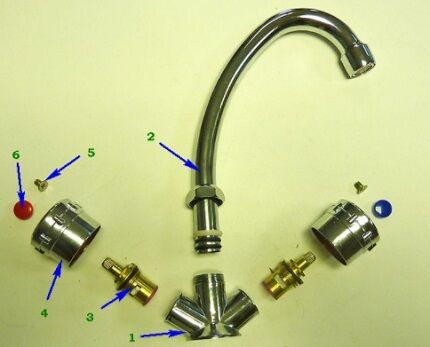
Two types of valve axle boxes are used in two-valve faucets:
- Worm-type locking elements. The rotation of the flywheel causes the piston to act on the rubber gasket, which locks or opens the hole. The rubber or silicone liner wears out over time and must be replaced.
- Ceramic crane axle boxes. The basis of the locking element is ceramic plate with holes for water supply. When the tap is turned, the plate unfolds and the hole aligns with the “water” channel. The larger the lumen area, the greater the volume of water supplied.
In ceramic models, the rotation of the flywheel is limited. The maximum rotation angle is 90-180°, which is significantly less than in mixers with a worm-type modification of the faucet axle.
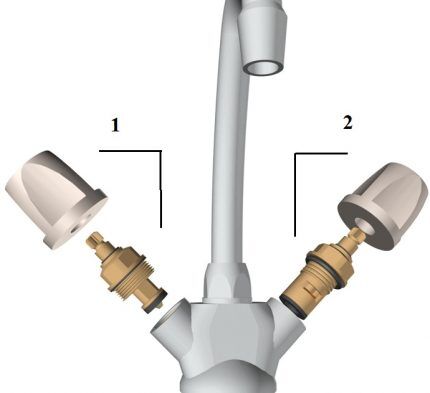
The main advantages of a two-valve mixer: strength of the body, interchangeability of parts and affordable cost. Their weaknesses are the need to insist on temperature conditions each time, and more frequent failures compared to other products.
Ease of use of a single-lever device
Single-grip models are in high demand due to their ease of control - the intensity of the water flow and temperature are regulated by moving a single lever in two multidirectional planes.
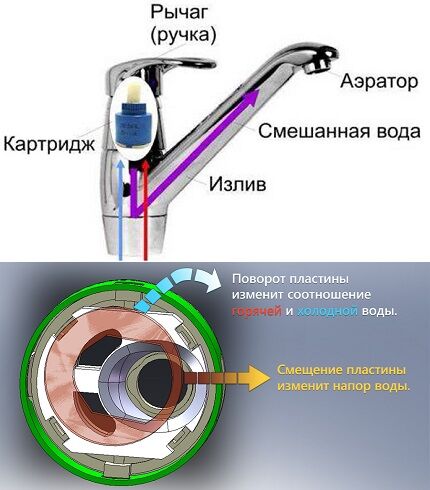
There are two types of switching mechanisms:
- disk (rod);
- ball
Disc cartridge. Replaceable mechanism with rotating ceramic discs. The work is based on the mutual movement of ceramic plates with cutouts.Depending on the number of plates, two- and three-disc cartridges are distinguished.
In a double-disc mixer, the upper plate is fixed to the control rod, the lower plate is rigidly fixed in the cartridge body.
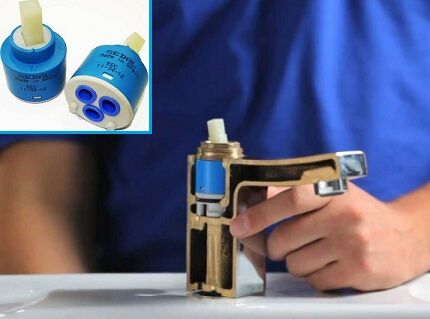
In three-disc cartridges, the middle plate is movable. The taps are suitable for low pressure water supply systems. The water is mixed in the valve body, and not between the plates, due to which the resistance inside the mixer is reduced.
Advantages of taps with disc cartridges:
- maintainability – to restore functionality it is enough replace internal mechanism;
- the increase in the cold water channel is proportional to the decrease in the flow of hot water - this ensures efficient use of water resources;
- ease of control.
The disadvantage of a ceramic cartridge is its vulnerability to hard, contaminated water. To use them, it is advisable to install a prefilter.
Ball mechanism. The regulator is made in the form of a hollow metal ball. There are three openings inside: two are side channels for water supply, one is for the mixed flow outlet.
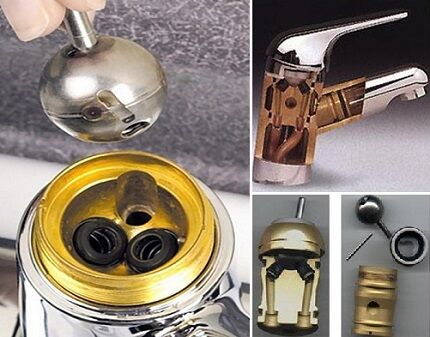
Since the mixing of water flows occurs inside a metal ball, scale forms on it - one of the reasons for the breakdown of the mixer.
We also recommend reading the article in which we described in detail the most common causes of breakdowns of ball mixers and how to fix them. Read more - read Further.
Additional disadvantages of the spherical mechanism:
- low maintainability;
- rapid wear of seals.
This device is resistant to pressure changes, water hammer, and is also less demanding on the quality of tap water.
You can read more about single-lever faucet models in this material.
Safety of using the thermostat
Devices with a thermostat ensure stability of the supplied water temperature. Outwardly, they resemble a traditional model - the body is equipped with two adjustment handles, an inlet and a spout. All technical differences are hidden inside.
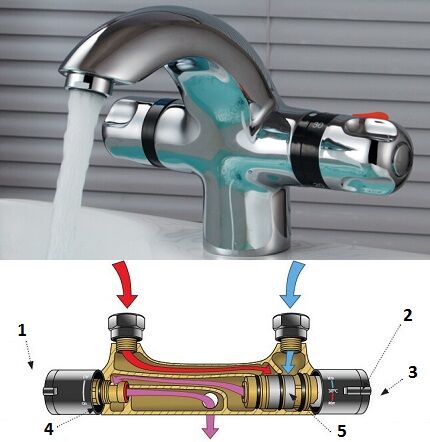
The heart of the mixer is a heat-sensitive element, which, under the influence of temperature, changes its size and regulates the volume of hot mixture. It is enough to configure the necessary parameters once, and subsequent adjustments are taken over by the thermostat.
Advantages of thermal mixers:
- safe operation - eliminates the risk of burns with hot water;
- ergonomic modern design;
- temperature stability and ease of use;
- reducing water consumption that could have been wasted on manual adjustments.
Before you choose thermostatic mixer For a bathroom sink, there are a number of things to consider. Firstly, the blocker stops the water supply if the temperature does not match the set value. In a house with a central water supply, where temperature fluctuations are frequent, you may not receive water at all.
Secondly, in systems with pressure surges, situations are possible when warm water is supplied from a “cold” pipe.The thermostatic mixer shuts off the hot water to reduce the temperature, but the user receives weak pressure at the outlet.
Mixers use two thermostat options: mechanical and electronic.
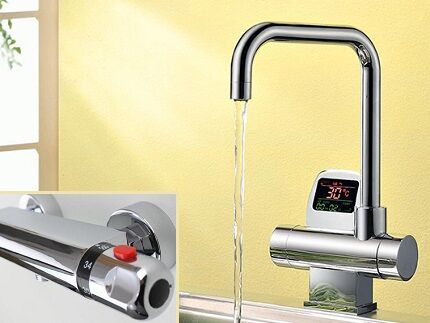
Mixer-doser – short-term water supply
Portion cutters, which are most in demand in public bathrooms, have also found their way into everyday life. The design of the mixer includes a water start button, a temperature regulator and a gander. When you press the key for some time, a portion of water is supplied.
The role of the locking element is played by a gasket placed on the extension of the rod. The components are placed in a special chamber - already mixed warm water enters this glass. The supply temperature is controlled by a side lever.
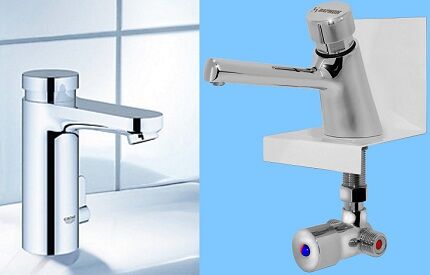
Using the valves will allow you to select the optimal position of the adjustable lever once and set a comfortable temperature.
The advantages of the mixer-dispenser are obvious:
- automatic shutdown;
- saving water temperature settings;
- Easy to use – just a light touch on the button.
Portion cutlery has a narrow purpose: hand washing, washing, light rinsing. The mixer is not suitable if using the sink involves a long supply of water and fine-tuning the temperature.
Features of electronic models
High-tech faucets are equipped with electronic components that are responsible for the accuracy of temperature heating and water pressure. Built-in sensors transmit a signal to the shut-off valve.
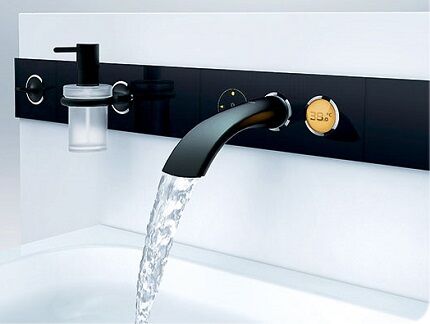
Based on the control method, a distinction is made between contact and non-contact electronic products.
Contact mixers. Touch control is provided - a display with an indication of current parameters and a settings panel is built into the molded case.
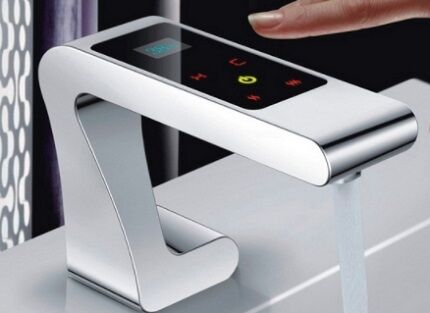
Non-contact devices. Controlled by motion sensors and infrared sensors that respond to thermal energy. If you bring a heat source, in particular your palms, under the spout, the sensor will trigger and water will flow.
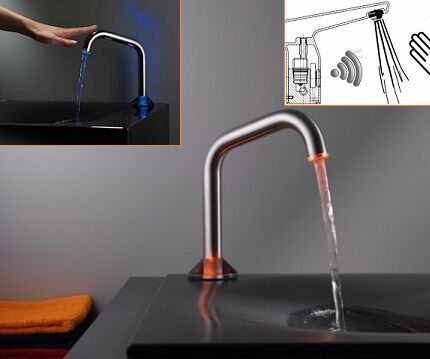
Advantages of electronics for the sink:
- advanced functionality;
- ease of use;
- modern design and decorative effects.
The main disadvantages of innovative plumbing: the high cost of the equipment itself, the complexity of repairs.
Parameters for choosing the optimal model
Having decided on the design, you should take into account some significant criteria: material of manufacture, geometric dimensions and shape of the gander, evaluate the functionality and method of installation of the device.Don’t forget about the compatibility of the faucet design with the interior of the room.
Mixer material
The determining factor in the durability and cost of a plumbing fixture is the material of manufacture.
Variety of mixer bodies:
- silumin;
- plastic;
- ceramic;
- steel;
- products made of copper alloys.
Silumin mixer. Economy segment products are made of aluminum with the addition of silicon. The material is characterized by fragility, low ductility and low ability to resist oxygen corrosion.
Silumin products are susceptible to high pressure, the maximum permissible value is 3 bar. In apartment buildings, the pressure in the water supply network can fluctuate up to 10 bar.
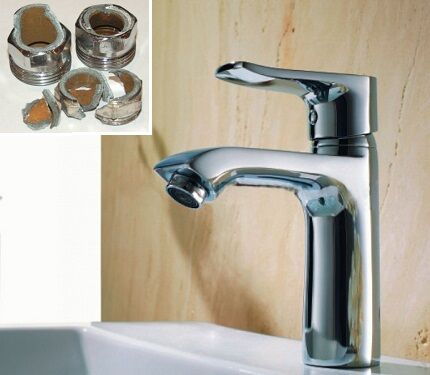
The only argument in favor of a silumin mixer is low cost. However, a cheap purchase carries the risk of an emergency.
Plastic case. Polymer products are affordable and do not corrode. Some models have an external coating that imitates artificial stone or chrome.

Acceptable material is ABS plastic. It is an impact-resistant, non-toxic thermoplastic polymer approved for use in plumbing fixtures.
Ceramic mixer. The body material is durable reinforced porcelain.Ceramics calmly reacts to contact with water, is durable and flexible, which makes it possible to produce faucets of any shape. The finished product is perfectly smooth, easy to clean, and does not wear out.
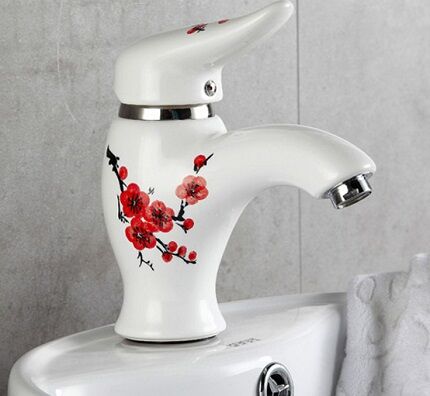
Stainless steel. Mixers in this category are a balance of reasonable price and decent quality. High-quality stainless steel can withstand high system loads, is not afraid of moderate mechanical stress and is durable.
When choosing a steel product, the main thing is not to be deceived by the composition of the material - there is a high risk of purchasing a fake. Little-known manufacturers add lead to brittle alloys to achieve the shine of true stainless steel.
Trusted companies provide a five-year warranty on the product, but in practice the service life reaches a quarter of a century.
Brass and bronze. Faucets made of copper alloys are considered the most reliable and durable. The material is undemanding to water quality and does not rust. Water stains and scratches are hardly noticeable on the bronze and brass body.
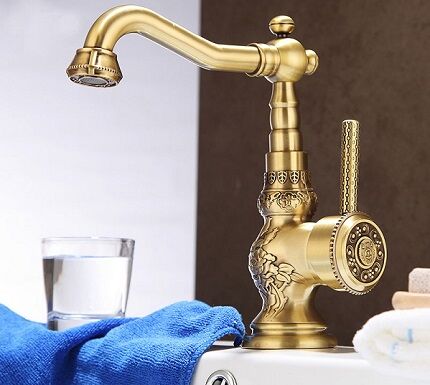
Spout length and shape
Ease of use depends on the geometric dimensions of the mixer spout. The height of the spout, the length and width of the gander are taken into account.
Height – distance from the base of the mixer to the spout nozzle, range of values – 20-900 mm.
Recommended indicators:
- 15-25 cm – if the sink is used only for hygiene procedures, a low gander fits under a shallow bowl;
- more than 25 cm – the location of the spout allows you to fill large containers with water.
A tall gander requires a deep washbasin to prevent splashes from flying around the room.

The width of the spout is determined by the cross-sectional shape of the spout: traditional and cascade. The first option is a tubular end with a round, oval or rectangular cross-section. The second is flat, wide models.
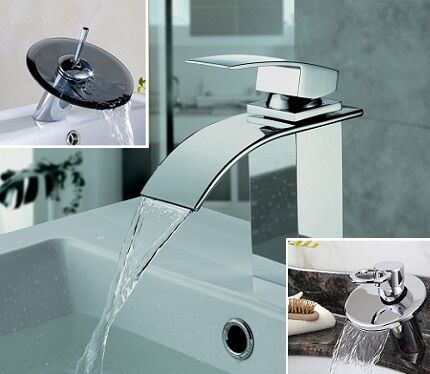
Functionality: rotatable and fixed body
The cast faucet body is ideal for a bathroom sink - the model is compact and reliable. The absence of rotating mechanisms and connection units minimizes the likelihood of breakdown and facilitates maintenance.
The prefabricated body of the model is more functional - the gander can be rotated to a position convenient for the user. If the faucet is intended to simultaneously serve a bathtub and a sink, then you should take a closer look at models with a telescopic spout.
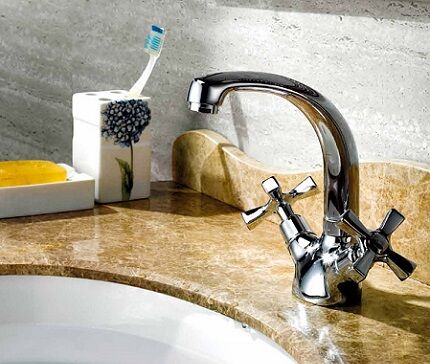
Determining the installation method
Depending on the location and installation method, the entire range of mixers is classified into four groups:
- wall mounted;
- wall built-in;
- outdoor tabletop;
- floor
Wall mounted faucets. Wall-mounted models are easy to install, easy to replace, and affordable. Wall-mounted “open” faucets with a long jib are often chosen as a single source of water supply to the bathtub and washbasin.

Tabletop models. The mixer is built into the side of a countertop washbasin or cut into the countertop.
Tabletop installation is suitable for plumbing fixtures with special mounting holes.

Floor-standing. Mixers are a pipe fixed to the floor with a plate - a sole.
Installation involves a lower water supply. It is necessary to lay communications in the floor screed in advance and leave outlets.
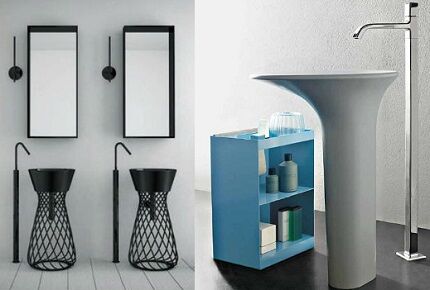
Design tricks or interior highlights
It is clear that the mixer should not lag behind the chosen style direction. An ornate two-valve antique faucet will look ridiculous in an interior designed in a minimalist style.
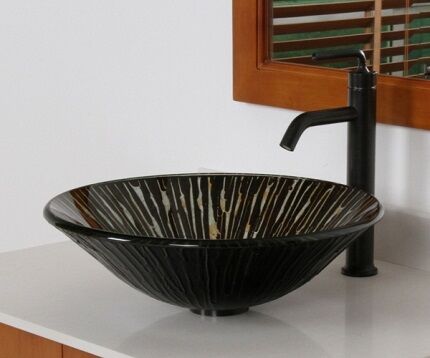
The variety of unusual and original options is impressive.
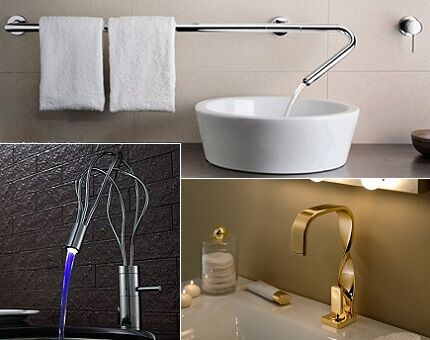
Some manufacturers offer ready-made kits - designer bathroom sinks with a built-in faucet.
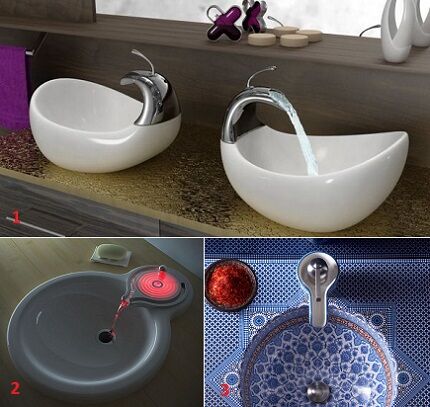
It would seem that such a banal thing as a faucet, with skillful choice, can transform any interior. Many designer delights are comparable to works of art and have a corresponding price. However, even among budget faucets you can find something exclusive.
You can read about the intricacies of installing mixers Here.
How to choose a manufacturer?
Recognized leaders in the plumbing products market are German, Finnish and Italian brands.
Among the reliable manufacturers are world-famous companies:
- Grohe. A German company that uses its own developments and innovations in the production of plumbing fixtures. There are more than 30 series of faucets of different styles and materials on sale.
- Hansgrohe. Specializing in the production of plumbing fixtures for over 100 years. The company sells products under 4 brands: Hansgrohe – modern-style faucets, Pharo – bathroom accessories, Pontos – economical technologies, Axor – exclusive models.
- Oras. Finnish company that prefers modern style. Her preferences: futurism, hi-tech, minimalism and modernism. Features of mixers: laconic design, dynamism, functionality and high quality.
- Jacob Delafon. French brand, representative of the Kohler group of companies.The quality of materials meets high European standards. Jacob Delafon offers more than 10 collections of faucets.
The top ten manufacturers are completed by: Rosa (Spain), Teka (Spain), Vidima (Bulgaria), Lemark (Czech Republic), Ideal Standart (Germany), Jika (Czech Republic).

Conclusions and useful video on the topic
Visual video tutorials will help you navigate the variety of models and choose the best one. The video will tell you what to consider when choosing a water “mixer”:
Determination of crane sizes for easy use in the video:
When purchasing, you must read the accompanying documents, check the smooth running of the moving elements and the quality of the external coating - there should be no drips, scratches or other defects. Experienced plumbers advise you to beware of suspiciously cheap and light-weight faucets - these are clear signs of a fake.
If you have interesting information on the topic of the article, please share it with our readers. Tell us which mixer you chose, are you satisfied with its performance? Perhaps you managed to purchase a new model? Leave comments and upload photos of your faucets in the comments section.




We have a single-lever mixer in our kitchen; it seems to me much more practical than a classic one. True, over time the mechanism began to become loose, but they repaired it themselves. But in movie theaters, sometimes you go into the restroom and looking at the faucet, you don’t know where to press.There was a case when I put my hands up, I thought it was contactless, but it didn’t work, after a few seconds, having studied the design of the mixer, I found the button and water started flowing. The variety of models and methods of water supply presented here by the author is very impressive.
In the bathroom we currently have a single-lever mixer with a ball switch mechanism. Before it there was a classic two-valve mixer with a worm-gear modification of the faucet, it was quite boring, it took a long time to select the desired temperature regime, and it looked too simple. I’ve seen contactless faucets in public places, but ideally I would like a thermal mixer for my home.